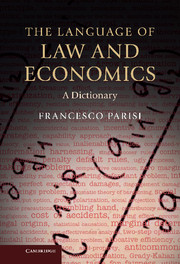S
Published online by Cambridge University Press: 04 August 2017
Summary
Safety in numbers versus danger in numbers: the idea of safety in numbers developed from empirical evidence showing that, for any given individual in a group, the probability of being the victim of a bad event decreases with group size. The concept was first introduced into the statistical literature by Reuben Smeed (1949), who found an exponential relationship (known as Smeed’s law) between per capita accident rates and the number of drivers. There are several explanations of the safety in numbers rule, ranging from biological explanations of group behavior to the idea that mass behavior is more predictable and easier to control, to the idea that greater precaution investments are taken by prospective tortfeasors when risks are multiple. The expressions “danger in numbers” and “safety in prominence” have been used to describe the opposite hypothesis, that per capita risk may actually increase with group size. Rather than describing some empirical regularities, these concepts find applications in a limited set of situations, mostly characterized by intentional mass harm. For example, the use of a popular software platform may increase the per capita risk of being the victim of a cyber-attack. In the case of terrorist attacks, the probability of being a victim of a suicide bomber may increase when traveling on a crowded bus or being in a busy restaurant. Being alone or in prominence pose lower risks of an attack. See also Smeed’s law.
Safety in prominence: see safety in numbers versus danger in numbers.
Salience: the perceived importance or quality of an element relative to neighboring and competing elements. Behavioral law and economics scholars use salience to describe a mechanism that attracts the attention of individuals with limited cognitive resources. Focusing on the more salient elements facilitates learning and the decision-making process. However, behavioral law and economics point to the possible biasing effects of salience in decision-making. See also salience and dominance in experiments, cognitive bias, behavioral law and economics, and debiasing.
- Type
- Chapter
- Information
- The Language of Law and EconomicsA Dictionary, pp. 264 - 292Publisher: Cambridge University PressPrint publication year: 2013



